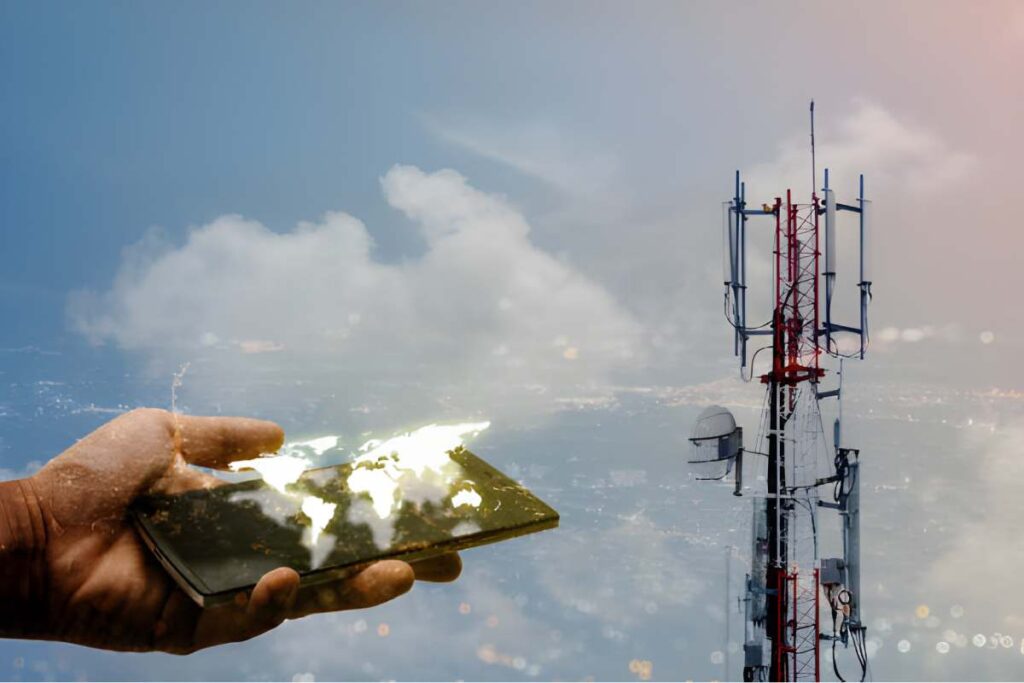Smartphone Satellite Connectivity allow users to send messages and sometimes make calls without using 4G or 5G networks. Instead, the phone connects directly to satellites in space. This helps users stay connected in remote areas or during natural disasters. Companies like Apple, Huawei, and Samsung are starting to release phones with this feature. Some companies, like Starlink, are committed to helping everyone. They want to ensure people worldwide have internet access and always stay connected. You can call for help or check the news without a cell signal.
What Is Satellite Connectivity on Smartphones?
Satellite Connectivity on smartphones means your phone can connect directly to satellites, rather than relying solely on cell towers. This is no longer science fiction. It’s already changing the way we think about mobile communications.
Typically, your phone relies on cell towers. But the signal often drops if you’re in a remote village, a dense forest, or an area hit by a cyclone. Satellite internet solves this problem by connecting your phone to low-orbit satellites. These satellites are closer to Earth than older ones, making the connection faster and more stable.
The advantage is simple: you can still stay connected even if all the cell towers fail. This technology is already saving lives in disaster-prone regions. Soon, many smartphones will be equipped with special chips that can communicate with satellites. More and more phone manufacturers will integrate these chips into their phones.
Satellite communication allows your phone to send SOS messages and tell you where you are, even if no cell towers are nearby. This ensures people’s safety and helps rescuers find them. It can also help multiple devices communicate with each other anywhere in the world.
How Does Satellite Connectivity on Smartphones Work?
Satellite Connectivity virtually eliminate the need for ground-based towers. Typically, your phone sends a signal to the nearest cell tower, retransmitting it via cables or microwave links. In satellite phones, the signal reaches satellites in low-Earth orbit (LEO), which orbit 500 to 2,000 kilometres above us.
Why use LEO satellites? They are much closer than traditional geostationary satellites, which orbit 36,000 kilometres. This nearness reduces latency and speeds up data transfer. For example, Starlink already has over 6,000 satellites that provide internet access. This same system can connect smartphones, providing coverage virtually worldwide.
Regarding hardware, satellite phones have special antennas and modems that can switch between cellular and satellite networks. Intelligent AI-powered software helps manage this switching so your phone can connect to the satellite when 5G or LTE signals are unavailable.
From Emergency SOS to Full Internet Access
The first real-world example appeared in 2022 with Apple’s iPhone 14. The Emergency SOS feature was developed, relying on satellite signals. This allowed people in North America and parts of Europe to send messages for help even if their phones had no signal. Apple later added this feature to the iPhone 15 and iPhone 16. More optimised features are expected in the upcoming iPhone 17 models.
In 2023, Huawei went even further. The Huawei Mate 60 Pro enabled two-way satellite messaging via China’s Tiantong satellites. This meant users could chat, not just send periodic SOS signals.
Samsung also joined this fray in 2024. The Galaxy S24 Ultra was announced with satellite connectivity, primarily for disaster recovery and off-grid communications.
The future is clear. This technology will not be limited to SOS. Companies like Starlink are partnering with T-Mobile. They want to create phones that can use the internet from space. This means you’ll be able to use the internet on your cellphone practically anywhere, even in the mountains or at sea. Soon, phones may not need Wi-Fi or cell towers to function. This is great, because people can communicate, play games, and watch videos while far from civilisation. In short, smartphones will soon connect directly to space-based broadband internet.
Integration with AI and Smart Technology
Satellite communications are more than just hardware upgrades. Real progress is achieved through AI. Smartphones like the iPhone 16 Pro Max, Google Pixel 10, and Samsung Galaxy S25 use built-in AI to manage power, signal strength, and the overall user interface.
And here’s where things get interesting:
- AI assistants like Siri with Perplexity AI in iOS 26 can predict when you’ll lose cellular signal and download critical data before it happens.
- Google’s Genie 3 AI assistant can switch to satellites for real-time translation or navigation updates, even without an internet connection.
- AI data compression ensures satellite data uses very little bandwidth, delivering messages faster and more reliably.
Simply put, AI turns satellite links into intelligent connections, allowing your phone to choose the best way to stay connected without you even noticing.
Smartphone Models Supporting Satellite Connectivity
Some flagship phones already support some form of satellite connection. Here’s a quick overview:
| Smartphones | Satellite Features | Provider / Tech Used | Status |
| Apple iPhone 14 / 15 / 16 series | Emergency SOS messaging | Globalstar satellite | Active (limited regions) |
| Huawei Mate 60 Pro | Two-way satellite messaging | Tiantong satellite | Active (China) |
| Samsung Galaxy S24 Ultra | Satellite messaging (pilot) | Likely Iridium / Partnerships | Announced |
| Google Pixel 10 (rumoured) | AI-optimised satellite fallback | Starlink partnership expected | 2025+ |
This table shows that satellite connectivity is a reality. Currently, it can include everything from messaging to full internet access in the future. More and more smartphones will support this feature.
The Role of Starlink Satellite Connection in Mobile Networks
Regarding satellite internet, one name in particular stands out: Starlink. Backed by SpaceX, the company provides broadband access to more than 2 million people worldwide. The next goal is to offer this service directly on smartphones.
The Starlink direct-to-cellular plan, announced jointly with T-Mobile in 2022, will initially allow text messaging via satellite. It will later include voice calls and data. By 2025, many Android and iOS phones will work seamlessly with Starlink satellite internet.
The implications are enormous. Instead of purchasing a separate Starlink satellite dish, your phone will act as a mini satellite terminal, ready to connect from anywhere on Earth.
Can Satellite Internet Replace 5G Networks?
A common question is: Will 5G render satellite internet useless? The answer isn’t that simple.
- Strengths of 5G: 5G is a powerful technology offering high speeds, minimal latency, and high city throughput.
- Strengths of Satellites: The power of satellites lies in their ability to cover the entire globe, reach remote areas, and operate during natural disasters.
- Weaknesses: However, satellites still have higher latency and lower throughput than fibre optic connections.
In the future, both technologies will likely be used simultaneously. Imagine your phone automatically switching between 5G and satellite connections, choosing the one that provides the best connection. This way, users always stay connected, enjoying the benefits of both approaches.
Challenges Holding Back Mass Adoption
Despite the enthusiasm, several challenges remain.
- Equipment Complexity: Installing satellite dishes on thin smartphones without excessive battery drain is challenging.
- Regulation: Many countries have strict rules regarding satellite communications and frequency use.
- Cost: Satellite services are more expensive than regular mobile data.
- Coverage Limitations: Current systems allow messaging, but a full internet connection requires more satellites.
However, as we have seen with 5G, these issues can be addressed over time.
AI, IoT, and the Future of Satellite-Connected Phones
Satellite communications won’t exist in isolation. They are closely linked to the IoT and AI revolution. Imagine:
- A self-driving car loses its 5G connection but seamlessly transitions to Starlink satellites.
- IoT container devices use satellites for real-time tracking.
- AI-powered agricultural drones connect via satellite, improving crop monitoring.
This combination of AI, IoT, and satellites is accompanying in a new era of intelligent systems where connectivity is seamless.
The Next Wave: Foldables, Wearables, and Satellites
We’re entering an era where not only smartphones, but also foldable phones and wearables will be compatible with satellites. Apple is rumoured to work on foldable iPhones with more powerful antennas for satellite reception.
Smartwatches will soon be able to send emergency calls directly via satellites, helping hikers and boaters even without a phone. Devices like health trackers and wildlife tracking sensors will also benefit.
This is the path to a world where everything—phones, watches, drones, and sensors—can communicate with satellites, providing worldwide connectivity.
Final Thoughts
A careful analysis of this trend reveals the most significant change since the advent of the mobile internet. Satellite communications on smartphones ensure that no one will be left without a connection, no matter where they live or travel.
Starlink internet, 5G, and intelligent computers will make using the internet anywhere effortless. It will feel like magic because it will always work.
In the future, phones won’t just be used in cities. Everyone, everywhere will be able to use them. The most significant change isn’t the phone itself. What matters is that no call for help will go unheeded. No voice will go unheard. Everyone will be able to stay connected.

